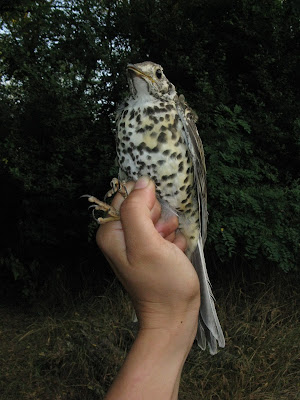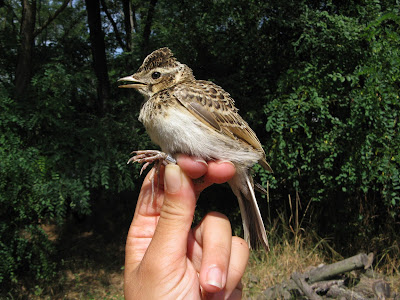21-27.8.2013
Text by Ron Efrat, pictures by Yael Lehnardt
נכתב על ידי רון אפרת, צילמה יעל לנרד.
 |
| פארק סלבורואה ובתי ויטוריה-גסטאיז ברקע, חבל הבאסקים Salburua Park and the edge of Vitoria-Gasteiz, The Basque country |
"קיבלתי הצעה מכמה חברים בצפון
ספרד, הם ישמחו אם נבוא לעזור להם בתחנת הטיבוע ל5-6 ימים, רוצים?". ככה
מצאנו את עצמנו נוחתים במלגה בשש בערב, קמים לטיבוע בשש בבוקר ואחר הצהריים יוצאים
צפונה לנסיעה "קצרה" של כ-12 שעות+ התעכבויות קלות. אבל רגע לפני הצפון
הרחוק, כמה מילים על היום הראשון במלגה.
"A few friends of mine
heard you are coming and asked if we can come and help them in their ringing
station in northern Spain .
Sounds good?". This how we found ourselves landing in Malaga
at 6 PM , waking up at 6 AM for ringing and leaving in the afternoon, northwards,
for a "short" 12 hours trip+ some minor delays. But first a few words
about the first day in Malaga and
then back to the far north.
 |
| שיחנית קטנה מערבית Isabelline Warbler Iduna opaca |
 |
| תחמס חום צווארון Red-necked Nightjar Caprimulgus ruficollis |
לאחר מכן, בישר לנו שהשיחניות הקטנות
המערביות (אפשר לתת למינים החדשים האלה שמות נוחים בעברית בבקשה?!) נודדות מוקדם
מהצפוי העונה. לכן, החלטנו ללכת לטבע אותן מייד בבוקר המחרת, רגע לפני שהן נעלמות
לנו לאפריקה. התעוררנו לטיבוע שהתחיל בשמונה בבוקר, בזכות אחידות הזמנים באיחוד
האירופי. פרשנו רשתות בחושך אחרון וטיבענו עוד מין חדש אשר נראה קודם לכן בדרך
לאתר: תחמס חום-צווארון מדהים. המשכנו עם 17 מהשיחניות המיועדות ועוד כמה מינים
שהזכירו לנו את הבית.
We were welcomed by the one and only: Juan Ramirez, the Spanish-
becoming Israeli ringer and birdwatcher, or more important- a very good friend.
In less than one minute he pointed out the first new specie for us- Spotless
Starling (Sturnus unicolor), a less colorful but more vocally
interesting version of the common one. Then he told us that the Isabelline
Warbler (Iduna opaca) are migrating earlier than expected so we
decided to ring them as soon as possible, so we won't miss them till we'll back
from the north. The ringing of this species is done as part of a self-project
of some ringers in south Spain in attempt t understand the movements between
different breeding colonies and so it is important to ring as many before the
migration, when knowing which birds were in the area during breeding season.
We woke up the next day for a ringing session starting at 8 AM (thanks
to the European time unity), put up the nets before first light and ringed
another new species for us (which was seen on the road to the ringing site) a
beautiful Red-necked Nightjar (Caprimulgus ruficollis). We
continued with 17 of the Isabelline warblers and a few more nice species which
reminded us home- Israel .
 |
| לא הסיבה בגללה עלינו צפונה אבל שווה- ארוחת הבוקר Not the reason we traveled north but a good one- breakfast |
 |
| הסיבה בגללה כן הצפנו- ציפור קטנה וחומה עם פס נוסף במרכז הכיפה- קנית גדות The reason we traveled north- a little brown bird- Aquatic Warbler Acrocephalus paludicola |
 | |
|
 |
| Aquatic Warbler Acrocephalus paludicola קנית גדות |
 |
| בית הגידול המועדף על קנית הגדות, צמוד לעיר ויטוריה גסטאיז The preferred habitat of the Aquatic Warbler, Next to Vitoria- Gasteiz |
לאחר ארוחת צהריים ו"סיאסטה"
מסורתית (הרגשנו מחויבים לנהוג בהתאם לתרבות המקומית) יצאנו ליעדנו הצפוני- העיר
ויטוריה-גסטאיז (שם ספרדי ושם בסקי). שם חכתה לנו תחנת טיבוע אשר מהווה חלק
מפרויקט אירופי גדול לשימור קנית הגדות, ללמידת נתיבי הנדידה שלה ולניטור מצבה (AWCT- Aquatic Warbler Conservation Team).
"תחנת הטיבוע" היא מספר כסאות ושולחן מאולתרים בקצה שביל בתוך הפארק היפהפה
סלבורואה הגובל בעיר ויטוריה וצוות הטיבוע מורכב מ-3 מטבעים מנוסים ועוד מספר משתנה
של מתנדבים ומתלמדים. מדי יום טובעו כ-50 ציפורים ביניהן לשמחתנו הרבה הקנית בעלת שלושת
הפסים= קנית גדות, שיחניות רוננות, עלוויות איבריות (אשר פוצלו לאחרונה מעלווית
החורף), טפס עצים קצר-אצבעות וחרגולנים מנומרים שריגשו מאוד את המצטרף הזמני למסע
והשאירו את יעל אדישה, כיאה לאירופית מנוסה (הערת בעלת הבלוג- שטויות במיץ, זו
תמיד אחלה ציפור). חוץ מה"מיוחדים" נהנינו ממינים חובבי קנים מוכרים
יותר וכן, הבענו את ישראליותנו בלכידת דוכיפת שגרמה להתרגשות בקרב האירופאים
הותיקים אך לא בקרב החדשה (הוא מתכוון אלי).
After lunch and a traditional "Siesta" (When in Spain be Spanish) we left for our northern destination Vitoria- Gasteiz (Spanish and Basque names). There, we were welcomed at a ringing station which is a part of a wide European project, AWCT- Aquatic Warbler Conservation Team, to learn about (and conserve) the endangered Aquatic Warbler (Acrocephalus paludicola) . The "station" is a few improvised chairs and a table, located at the end of a trail in the beautiful :Salburua Park Vitoria . The wonderful team is based on 3 experienced ringers and a changing number of volunteers and trainees. Every day about 50 birds were ringed; among them were the long awaited Aquatic Warbler (Acrocephalus paludicola), Melodious Warblers (Hippolais polyglotta), Iberian Chiffchaffs (Phylloscopus ibericus) (another Spanish specialty), Short-toed Treecreeper (Certhia brachydactyla) and Grasshopper Warblers (Locustella naevia), which made the new traveler very excited but didn't excite the already European one (blog owners comment- nonsense, I'm always happy with this species!). Except for the "specialties" we enjoyed some more familiar species and got a little Israeli feeling in the shape of our national bird- a Hoopoe (Upupa epops).
 |
| הצוות The stuff |
Some of the ringed birds מהציפורים שטובעו
 |
| סיבה למסיבה- שיחנית רוננת, אחת מתוך כמה פרטים שטובעו made us very happy- Melodious Warbler Hippolais poliglotta |
 |
| מהציפורים הנפוצות ביותר בטיבוע- חטפית שחורת עורף One of the commonest birds in the ringing- Pied Flycatcher Ficcedula hypoleuca |
 |
| סתרי מצוי Dunnock Prunella modularis |
 |
| חרגולן מנומר Grasshopper Warbler Locustella naevia |
 | |
|
 |
| חיית מחמד מזדמנת- מין פולש מאמריקה A nice pet- an invasive species of crab from America |
 |
| חואן, הסרטן ופונטסו הסקרנית Juan, the American carb and curious Puntaso |
את הדרך חזרה עשינו בשילוב הפסקה
ממושכת- עצרנו ללילה ובוקר באנדוחר (Andujar) שבסמוך לחאן (Jaen) כדי לחפש את הלינקס האיברי המפורסם וציפורים נחשקות
נוספות. לינקס לא מצאנו ומעט עיטים נצפו, כנראה בשל שנה גרועה לארנבות באזור
(צפינו בשניים ספרדיים בלבד), אך נהנינו מאוד מהנוף המדהים של השטח השמור האינסופי וזכינו
להרחיב את רשימת המינים שלנו לספרד בכמה מיוחדים: שני עיטים ספרדיים בוגרים עם
"אורות הנחיתה" הבולטים שלהם, שני עיטים זהובים, חוגלות אדמוניות ולהקות
קטנות של עקעקים תכולים יפהפיים. בגזרת היונקים נהננו מעשרות איילים אדמוניים וכן משלוש יעלות
ספרדיות (Spanish Ibex) שהפתיעו אותנו במקום לא צפוי.
 |
| אנדוחר, אזור חאן Andujar, next to |
The way back to Malaga was
divided into two parts, when we spent the night and morning in Andujar, next to
Jaen , to look for the Iberian Lynx Lynx pardinus and some
eagles. The Lynx was not
found and only a few eagles were seen, probably because of the bad year for the
rabbits (At last, two Spaniish Imperial Eagles were seen). We enjoyed beautiful
scenery of a never ending preserved land and got some new species for our
Spanish list: 2 adult Spanish Imperial Eagles (Aquila
adalberti) with their prominent "landing lights", 2 Golden
eagles (Aquila chrysaetos), some Red-legged
Partridges (Alectoris rufa) and small flocks of the beautiful Azure-winged
Magpie (Cyanopica cyanus). In the mammal section we enjoyed dozens
of Red
deer
 |
| The closest we had with the Lynx- in the coffee after.. הכי קרוב שהגענו ללינקס הפעם- בקפה שאחרי התצפית... |































